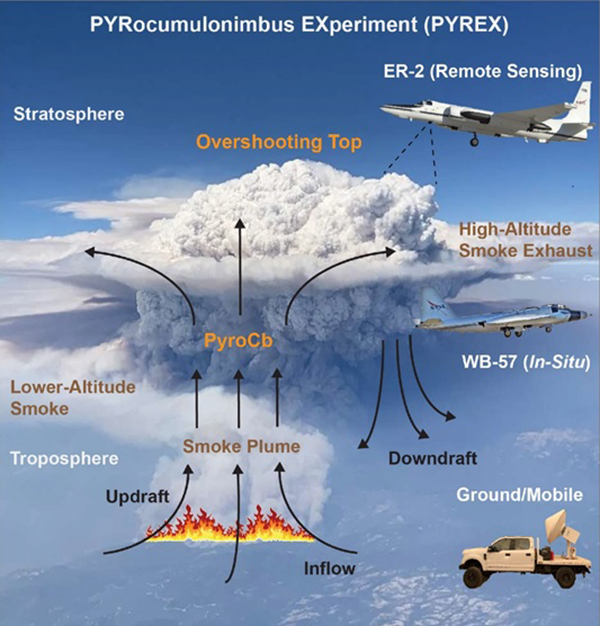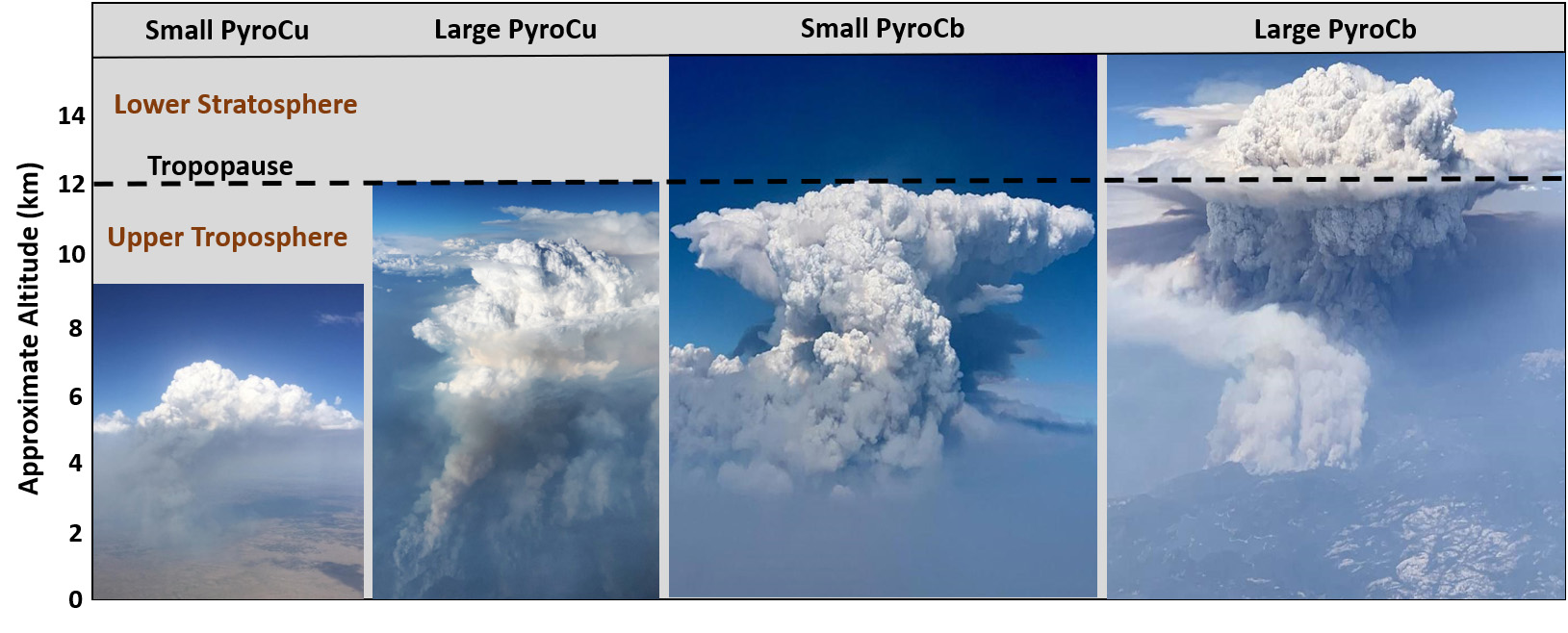WASHINGTON –
U.S. Naval Research Laboratory meteorologist, David A. Peterson, Ph.D., has been selected by the National Aeronautics and Space Administration (NASA) to lead the Pyrocumulonimbus (pyroCb) Experiment (PYREX), a large airborne-based field campaign aimed at studying the role that pyroCb activity plays in the warming climate system and understanding its physical links to extreme wildfire behavior. PYREX leadership also includes Neil Lareau, Ph.D., from the University of Nevada, Reno and Olga Kalashnikova, Ph.D., from NASA’s Jet Propulsion Laboratory.
The experiment is one of six new airborne missions funded through NASA’s Earth Venture program, and will receive $30 million for the study over the next five years. The study will investigate if increasing wildfire size and intensity in a warming climate will amplify pyroCb-driven smoke injection into the stratosphere, resulting in measurable alterations in the amount of sunlight absorbed and reflected by the Earth’s atmosphere.
PyroCbs are a poorly understood and inadequately predicted severe weather phenomenon driven by large and intense fires occurring in the presence of relatively distinct meteorological conditions. These fire-generated clouds are linked to extreme fire behavior that impedes firefighting efforts and devastates communities. PyroCbs also act as giant chimneys that can propel smoke plumes upward into the stratosphere, similar to a volcanic eruption. These plumes can encircle the globe, reside in the atmosphere for more than a year, alter weather patterns, extend the lifetime and size of the Antarctic ozone hole, and modify the temperature of the Earth’s surface and atmosphere. Given the ongoing and projected increases in fire activity and severity linked to a warming climate, there is an urgent need to better understand and predict climate- and fire-scale impacts from pyroCb activity.
 Pyrocumulonimbus mission overview, including a two-platform airborne configuration that will provide remotely sensed and in situ measurements for the full spectrum of fire and pyroconvection from the surface to the stratosphere.
Pyrocumulonimbus mission overview, including a two-platform airborne configuration that will provide remotely sensed and in situ measurements for the full spectrum of fire and pyroconvection from the surface to the stratosphere.
“PYREX provides an exciting opportunity to investigate the role of extreme wildfires and pyroCbs in the warming climate system,” said Dr. Peterson. “We will also fill critical forecasting gaps affecting fire management and public safety.”
This field campaign is based around addressing three primary science questions that establish links and feedbacks between the physical processes enabling the development of these unique storms, smoke injection high into the atmosphere, and downstream consequences:
- Which fires produce pyroCbs and why?
- What mechanisms determine whether a pyroCb will inject smoke directly into the stratosphere, and what will be the magnitude of the ensuing plume?
- How do pyroCb-injected smoke plumes modify critical processes in the atmosphere?
Conceptualized pyroCb feedback loop
The study will require sustained measurements and modeling of co-evolving fire and pyroCb processes, including fire energetics, plume development, pyroCb cloud properties, and smoke plume evolution. Achieving the objectives will require deployment of high- altitude flying aircraft and surface-based measurement platforms from field sites in the United States and Canada. The proposed sites include Palmdale, California; Boise, Idaho; and Cold Lake, Alberta, Canada. The study intends to sample several pyroCb events over large, intense fires during eight-week deployments in 2026 and 2027.
James Campbell, Ph.D., head of NRL’s Atmospheric Properties and Effects section, added “We are excited and proud to see David and his collaborative team awarded by NASA for the ground-breaking research that they’ve led into pyroCbs to date. The PYREX mission will address fundamental questions ranging from how day-to-day weather models predict extreme wildfire weather phenomena to how these smoke chimneys influence cloud formation, the chemical composition of the stratosphere and ultimately the climate.”
New observations of the Earth’s surface, wildfires, and atmospheric system will increase our understanding of complex phenomena in the global Earth system. PYREX has direct relevance to studies of atmospheric composition, weather and atmospheric dynamics, climate variability and change, the carbon cycle, and ecosystems. The experiment will improve understanding and predictive capability for changes in climate forcing and air quality associated with large wildfires, as well as the potential for climate feedbacks associated with increasing wildfire activity.
“The consequences from pyroCb smoke plumes observed in the lower stratosphere over the past ten years have created a significant knowledge gap,” said Dr. Peterson. “The onus now falls on the community to respond with field research that is dedicated to understanding pyroCbs and their impacts.”
The study will rely on multiple types of numerical models capturing different aspects of pyroCb science at different scales. The measurement components will make extensive use of models at fire-scale, coupled fire-weather, and regional composition and transport to derive flight plans and to target data collection. The mission will measure all parameters required for initialization of pyroCb smoke plumes in aerosol transport, chemistry, and climate models. The outcome of this mission will be an improved understanding of pyroCb phenomena that can be used to improve the fidelity of Earth system models in addition to those included in the PYREX study.
More than 140 pyroCb events were observed over Canada in 2023, far eclipsing any single year prior. The smoke released by pyroCbs in British Columbia, Yukon, and Alberta traveled far downwind, contributing strongly to air-quality and visibility hazards observed across the eastern United States, Canada, and even across the Atlantic. Combined with tragic fire-driven events in Hawaii and Greece, and a huge increase in North American fire activity on a decadal scale, it’s hard not to see the clear linkages between this activity and the warming climate overall.
 Full spectrum of pyroconvective activity and smoke injection altitudes targeted by this experimental concept, including maturing pyroCb and its precursor pyrocumulus (pyroCu) stages.
Full spectrum of pyroconvective activity and smoke injection altitudes targeted by this experimental concept, including maturing pyroCb and its precursor pyrocumulus (pyroCu) stages.
PYREX represents an opportunity to position the atmospheric physics and chemistry communities ahead of the curve in terms of what comes next as a result of pyroCb and strong pyroconvective storms. Far from the “niche” events they were once thought to be, the recent events of the past few years are harbingers of what is quickly becoming a “new normal”. How black carbon evolves in pyroCb smoke plumes, how it impacts other chemical compounds, how it interacts with solar and infrared radiation— these are the questions of our times, and arguably some of the most important aerosol-climate questions of the past 30 years.
PyroCbs are a result of the thermal buoyancy within a smoke plume, driven by the heat of the fire relative to the surrounding air. It is this fundamental process that determines the vertical limit of a rising plume, where smoke arrives in the atmosphere above the fire, and thus the downwind trajectory and lifetime of the smoke.
In some regions, like the tropics, smoke-plume-rise is damped by relatively low buoyancy, and the plumes typically do not reach high altitudes. In western North America, however, and other regions favorable to pyroCb development, the potential for plume rise is clearly significant. Measurements of detailed fire-smoke-weather processes are necessary to better understand pyroCb activity and smoke transport to the stratosphere.
The ramifications for understanding these initial stages of plume-driven dynamics will have equally long-lasting impacts on how we model fires of all scales and their downwind impacts on air quality and radiation. Global and regional-scale modeling of smoke transport is a decades-long endeavor that has never fully represented these important physical mechanisms in operational predictions.
The ability to accurately model smoke plume rise, from the surface to the lower stratosphere, will lead to consequential gains in forecast skill, both in terms of long-range smoke transport, surface air quality, feedbacks via light absorption, and impacts on clouds and weather. PYREX is not only timely, but fundamental toward a better understanding of fire and smoke for scientific research and operational prediction.
About the U.S. Naval Research Laboratory
NRL is a scientific and engineering command dedicated to research that drives innovative advances for the U.S. Navy and Marine Corps from the seafloor to space and in the information domain. NRL is located in Washington, D.C. with major field sites in Stennis Space Center, Mississippi; Key West, Florida; Monterey, California, and employs approximately 3,000 civilian scientists, engineers and support personnel.
For more information, contact NRL Corporate Communications at (202) 480-3746 or
nrlpao@us.navy.mil.